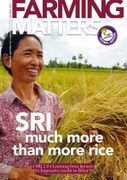The System of Rice Intensification is a very good example of agro-ecology in action, argues Rik Thijssen.Some thirty years ago, near the town of Nagua in the Dominican Republic, small-scale rice farmers were experimenting with transplanting seedlings.Today, just like back then, farmers are taking the lead.

This forced the unlucky farmers to experiment with a larger planting distance which would allow them to employ manual weeding techniques (rather than rely on what were now unaffordable chemicals) and to use manure instead of expensive chemical fertilizers. They planted a mixture of older seedlings and younger ones from a second seedbed and varied the number of seedlings per hole. I saw them obtain yields that were up to 90% of those of their colleagues with credit facilities.
The lecturers at the university where I was studying bluntly silenced my enthusiasm about these observations, stating that the way to produce rice was already “well-established and crystal clear”, and that any other approach was non-productive. What I learnt was that this rigid production model does not fit the many uncertainties – or opportunities – that rice farmers face. And that it has neither allowed for any real breakthrough as far as production levels are concerned!
Since 1999, the System of Rice Intensification (SRI) has been spreading from Madagascar to many other countries. Thanks to the efforts of many people, and to the information shared in, among others, the old LEISA Magazine (with articles I had the good fortune to select and edit), many people have been motivated to experiment with the approach and evaluate it for themselves. And this process is ongoing.
Some of the farmer groups I worked with in Indonesia, for example, were sceptical when they first heard about SRI. Then some – often younger – farmers would try it and allow the whole group see the results. What appealed to me most was that, in their enthusiasm, some farmers would carry on experimenting.
On the island of Timor, for instance, some farmers used to leave a few roselle plants (Hibiscus sabdariffa) growing in rice fields when they did their weeding as these provided a spice used to flavour local meat dishes. When farmers learned about the high economic value of the dried red calyces of the roselle flowers, they immediately started trying out larger quantities of roselle in their traditionally mono-cropped rice fields.
Now, like thirty years ago, this is agro-ecology in action. And everywhere farmers are taking the lead.
Text: Rik Thijssen
Rik Thijssen worked with Salam, in Indonesia, and also as editor of the LEISA Magazine. He currently works as a writer and independent consultant. E-mail: hjcthijssen@on.nl

